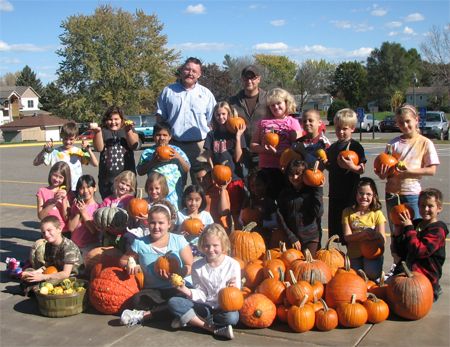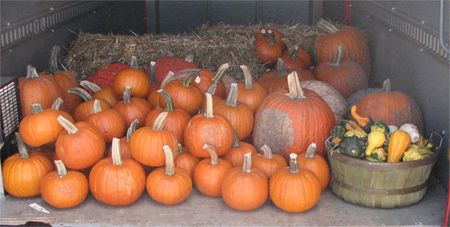The Great Pumpkin Heist
Every spring at Salem Hills Elementary (Inver Grove Heights), the current third grade class plants a vegetable garden for the new class in the fall. This creative classroom teaches students more than just a direct lesson about where food comes from. The teachers, Ms. Gustafson and Mr. Melde, also take the opportunity to teach botany, math, and scientific experiments outside traditional classroom methods. At the end of the school year, the students who enjoyed the fruits of the garden in September participate in the continuation of the cycle by planting a garden for a group of new third graders.
 |
| Salem Hills 3rd Graders Showing Off Their Newly Donated Pumpkins |
In October 2010 the cycle was interrupted. On a visit to their garden, the students and teachers discovered the dozen pumpkins that had been growing in their patch were either missing or smashed. Perhaps most upsetting to the kids was the destruction of their mascot pumpkin, “Pump.” (Earlier in the growing season the letters P-U-M-P had been etched into the pumpkin’s rind to show how the scar tissue would heal the “wound” and make the letters more pronounced.) I learned of the theft and the broken hearted kids when an article was published in the St. Paul Pioneer Press.
With permission from our owners, a few of us loaded Gertens’ red delivery truck with hundreds of pumpkins to replace those that were lost. We included a number of the standard jack-o-lantern variety, but to make it more fun, we also brought little kid-sized Pie pumpkins, the flattened bright orange Cinderellas, similarly flat but tan colored Long Island Cheeses, white Silver Moons, orange and white One Too Manys, and the most popular of the day, warty orange Knuckle Heads. (Among the many questions we fielded that afternoon, the one I enjoyed most was whether or not the warts on that particular type of pumpkin were contagious.)
We pulled up to the school on a beautiful, sunny fall afternoon. As we waited for the two classrooms to come outside and meet us, I realized I had no idea what we were going to talk about. Little did I realize, my plans or lack thereof, were immaterial. It had been a while since I’d been around such a large herd of third graders (since I, myself was nine) and had forgotten that regardless of any speaking points I could bring to the table, by the very nature of this age group, the agenda was entirely theirs. Ms. Gustafson briefly introduced us and I told of how Gertens learned what had happened. Then in asking the question: “What do you grow in your garden?”, the seated crowd before me became a flutter of raised hands. For the better part of an hour we talked about beans, tomatoes and the reason why sunflowers are known as tourne soleil in French. We explored the miraculous nature of the seed and how quickly it becomes a plant; and also how flowers become fruit.
 |
| Gertens loaded our own truck and off to school... |
Then we opened the rear doors of the truck and the oohs and excitement rivaled any Fourth of July evening. With the help of a few of the students we unloaded our cargo into an ever growing pile of colors and shapes on the sidewalk. As we stacked them, orange, white, blue or bumpy, we heard the question, “Is that really a pumpkin?”.
That brief bit of a warm afternoon, the questions, conversations and those faces were all priceless. Being one of the messengers, the Bringers of the Pumpkins, on Gertens behalf was equally so. At the end of our time, Ms. Gustafson spoke to the class about how sometimes bad things have to happen so that people have the opportunity to help one another. The children showed agreement by nodding heads and with bright smiles. Of all the classroom lessons and uses to which the pumpkins could be put, that seemed the best of all.
With a final shout of thanks the kids grabbed pumpkins from the pile, pairing up for those larger and heavier, and carried them back to their classroom.
Erik Carlson
Customer Service Manager
